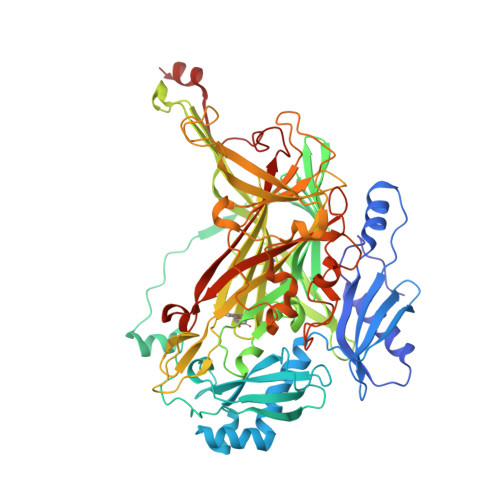Exploring molecular oxygen pathways in Hansenula polymorpha copper-containing amine oxidase
Johnson, B.J., Cohen, J., Welford, R.W., Pearson, A.R., Schulten, K., Klinman, J.P., Wilmot, C.M.(2007) J Biol Chem 282: 17767-17776
- PubMed: 17409383
- DOI: https://doi.org/10.1074/jbc.M701308200
- Primary Citation of Related Structures:
2OOV, 2OQE - PubMed Abstract:
The accessibility of large substrates to buried enzymatic active sites is dependent upon the utilization of proteinaceous channels. The necessity of these channels in the case of small substrates is questionable because diffusion through the protein matrix is often assumed. Copper amine oxidases contain a buried protein-derived quinone cofactor and a mononuclear copper center that catalyze the conversion of two substrates, primary amines and molecular oxygen, to aldehydes and hydrogen peroxide, respectively. The nature of molecular oxygen migration to the active site in the enzyme from Hansenula polymorpha is explored using a combination of kinetic, x-ray crystallographic, and computational approaches. A crystal structure of H. polymorpha amine oxidase in complex with xenon gas, which serves as an experimental probe for molecular oxygen binding sites, reveals buried regions of the enzyme suitable for transient molecular oxygen occupation. Calculated O(2) free energy maps using copper amine oxidase crystal structures in the absence of xenon correspond well with later experimentally observed xenon sites in these systems, and allow the visualization of O(2) migration routes of differing probabilities within the protein matrix. Site-directed mutagenesis designed to block individual routes has little effect on overall k(cat)/K(m) (O(2)), supporting multiple dynamic pathways for molecular oxygen to reach the active site.
Organizational Affiliation:
Department of Biochemistry, Molecular Biology and Biophysics, University of Minnesota, Minneapolis, Minnesota 55455, USA.




















